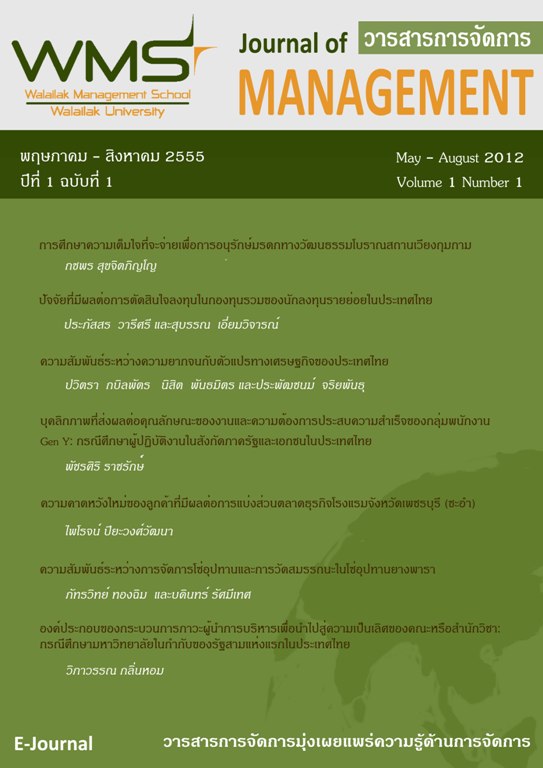The elements of administrative leadership procedure towards faculty excellence: case study of three original public autonomous universities in Thailand
Main Article Content
Abstract
Article Details
References
จำเนียร จวงตระกูล 2551. การวิจัยเชิงคุณภาพ: เครื่องมือสร้างองค์ความรู้เพื่อการพัฒนาประเทศ. กรุงเทพฯ: บริษัทศูนย์กฏหมายธุรกิจอินเตอร์เนชั่นแนล จำกัด
จำเนียร จวงตระกูล 2552. กลยุทธ์การจัดการทรัพยากรมนุษย์: ทฤษฎีและการปฏิบัติ.กรุงเทพฯ: บริษัทศูนย์กฏหมายธุรกิจอินเตอร์เนชั่นแนล จำกัด
จำเนียร จวงตระกูล 2553. การพัฒนาทรัพยากรมนุษย์: ทฤษฎีและการปฏิบัติ.กรุงเทพฯ: บริษัทศูนย์กฏหมายธุรกิจอินเตอร์เนชั่นแนล จำกัด
อภิสิทธิ์ เวชชาชีวะ 2554, 07 07. แผน 11 เพื่อการพัฒนาที่ยั่งยืนในห้าปีข้างหน้า. บันทึกข้อมูลเมื่อ 08 08, 2554 จาก http://www.abhisit.org/visiondetail.php.
ATLAS.ti Scientific Software Development. 2011. The handbook and user’s guide to ATLAS.ti 6.2. Berlin: ATLAS.ti Scientific Software Development.
Armstrong, M. 2010. Armstrong's essential human resource management practice: A guide to people management. London: Kogan Page.
Association of American Universities, Association of Research Libraries, The Coalition for Networked Information, and National Association of State Universities and Land Grant Colleges. 2009. The university’s role in the dissemination of research and scholarship — A call to action. Retrieved August 20, 2011, from www.arl.org/bm~doc/disseminating-research-feb09.pdf.
Berg, B. L. 2004. Qualitative research methods for the social sciences (5th ed.). Boston: Pearson.
Buytendijk, F. 2009. Performance leadership: The next practices to motivate your people, align stakeholders, and lead your industry. New York: Mc Graw-Hill.
Cheaupalakit, P. 2002. The leadership styles of male and female higher education administrators in Thailand. Illinois: Illinois State University.
Corbin, J., & Strauss, A. 2008. Basics of qualitative research: Techniques and procedures for developing grounded theory (3rd ed.). Thousand Oaks, CA: Sage.
Creswell, J. W. 1998. Qualitative inquiry and research design choosing among five traditions. London: Sage.
Cummings, T. G., & Worley, C. G. 2009. Organization development and change. Mason, OH: Thomson South-Western.
Daft, R. L. 2005. The leadership experience. Australia: Thomson South-Western.
Denzin, N. K., & Lincoln, Y. S. 2008. Strategies of qualitative inquiry (3rd ed.). Thousand Oaks, CA: Sage.
French, W. L., Bell, J. R., & Zawacki, R. A. 2005. Organization development and transformation: Managing effective change (6th ed.). New York: McGraw-Hill.
Glaser, B.G., & Strauss, A. L. 1967. The discovery of grounded theory strategies for qualitative research. Illinois: Aldine Publishing.
Gmelch, W. H. 2000. Leadership succession: How new deans take charge and learn the job. The Journal of leadership Studies, 7(3), 68-87
Kotter, J. P. 1990. A force for change: How leadership differs from management. New York: Macmillan.
_______. 1999. What leaders really do. Boston: Harvard Business School Press.
Lincoln, Y. S.and Guba, E. G. 1985. Naturalistic Inquiry. California: Sage Publications, Inc.
Maykut, P., & Morehouse, R. 1994. Beginning qualitative research aphilisophic and practical guid. London: The Falmer Press.
McKee, J. G. 1991. Leadership styles of community college presidents and faculty job satisfaction. Community/Junior College Quaterly of Research and Practic, 15(1), 33-46.
Merriam, S. B. 1998. Qualitative research and case study applications in education. San Francisco: Josset-Bass.
Miles, M. B., & Huberman, A. M. 1994. Qualitative data analysis (2nd ed.). London: Sage.
Moore, L. L., & Rudd, R. D. 2004. Leadership skills and competencies for extension directors and administrators. Journal of Agricultural Education, 45(3), 22-33.
Northouse, G. P. 2004. Leadership: Theory and practice (3rd ed.). Thousand Oaks, CA: Sage.
Patton, M. Q. 1990. Qualitative evaluation and research methods (2nd ed.). London: Sage.
Pitugtham, P. 2006. Leadership of Education Executive to Effective in Education Management Process: In Case of the Public Higher Education in Songkha Provience. the Academic National Conference of the Political Science and Public Administration 7th.
Quinn, R. E., Faerman, S. R., Thompson, M. P., & McGrath, M. R. 1996. Becoming a master manager: A competency framework (2nd ed.). New York: John Wiley & Sons.
_______. 2003. Becoming a master manager: A competency framework (3rd ed.). New York: John Wiley & Sons.
Rosen, R., & Digh, P. 2001. Developing globally literate leaders. Training and Development, 55(5), 70–81
Saldana, J. 2009. The coding manual for qualitative researchers. Thousand Oaks, CA: Sage.
Sriyanalugsana, C. 2008. A comparative study of administrative leadership in Thai universities. Melbourne: Victoria University.
Soy, S. K. 1997. The case study as a research method. Austin, TX: University of Texas at Austin.
Stake, R. E. 1995. The art of case study research. Thousand Oaks, CA: Sage
_______. 2008. Qualtative case studies. In Denzin. N. K. & Lincoln. Y. S (Eds.), Strategies of qualitative inquiry (pp. 119-149 ). Thousand Oaks, CA: Sage.
_______. 2010. Qualitative research: Studying how things work. New York: The Guilford Press.
Strauss, A., & Corbin, J. 1990. Basics of qualitative research grounded theory procedures and techniques. Thousand Oaks, CA: Sage
Swanson, R. A., & Holton, F.H. lll. 2001. Foundations of human reource development. San Franciso: Berrett-Koehler.
The Commission on Higher Education Board. (2008). The commission on higher education planning (2008-2022). Bangkok: Commission on Higher Education.
The Office of the National Economic and Social Development Board of Thailand. 2007. Economic and social development plan (2007-2011). Bangkok: The Office of the National Economic and Social Development Board of Thailand.
_______. 2011. Economic and social development plan (2012-2017). Bangkok: The Office of the National Economic and Social Development Board of Thailand.
Times Higher Education Supplement (THE). 2010. The world university rankings 2010. Retrieved August 20, 2011, from
http://www.timeshighereducation.co.uk.
_______. 2011. World-university-rankings. Retrieved August 09, 2011, from www.timeshighereducation.co.uk.
Tunhiem, K., & Manderscheid, S. 2007. Presidents in crisis?: An exploratory study for understanding leadership challenges in higher education In The 6th International Conference of the Academy of HRD. Beijing, China.
Whiteley, A. 2011. An integrated approach to organizatioanl research: Managers as Researchers. RBAC International Management Conference 2011: Creative Economy, Creative Business, Creative People: Human Capital as a Key Driver for Sustainable Success. Bangkok: Graduate School of Business, Curtin University, Australia.


